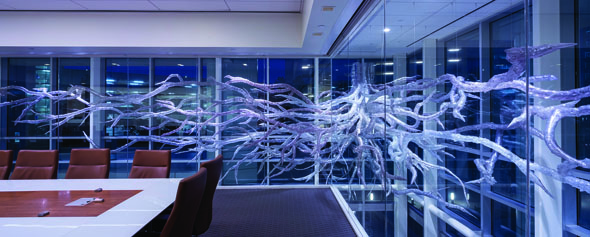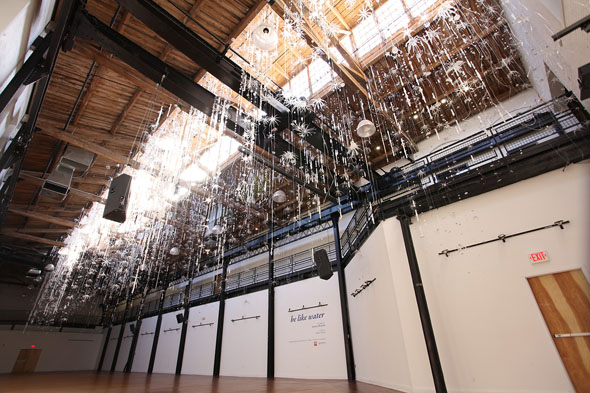The Ethereal World of Aurora Robson

For artist Aurora Robson, art is a dialogue. While many are attracted to her work simply for its beauty and grace, a much deeper conversation is taking place. Fused in every piece, shape, and sculptural creation is the message of the devastating impact our collective plastic consumption is reaping on the environment.
Robson creates sculptures, installations, and collages by intercepting the waste stream and collecting trash plastic debris from creeks, streets, and urban centers. “My work is largely about transforming something negative into something positive,” explains Robson. “One of the first things we observe about trash is that it is material that people don’t care about or see value in, so I take the time to care about it in every aspect. I try to reveal its hidden potential.”
Robson’s gift for transforming trash into art has created an impressive following. She’s has been commissioned to create artworks for a vast range of companies, such as the Four Seasons Hotel, Bank of America, and The Franklin Park Conservatory & Botanical Gardens, often using the companies’ own trash to make the works that will hang in their space. Her most recent large-scale installation, Plant Perception, at Noble Energy is 65 feet long and constructed from 6,000 reclaimed PET bottles.
“I was thinking about how plants grow in the direction that is most suitable to them—where the minerals and soil conditions are optimal,” says Robson. “I try to reference how delicate, magnificent, and diverse life on earth is in the work and conjure up situations that give people an opportunity to reflect on that and on our own vulnerability as a species. I try to create work that really honors nature.”
Plant Perception pours from the ceiling of a conference room, floating overhead and around. It is both otherworldly and delicate. At a quick glance, it gives the illusion of ever-stretching branches, but a closer look reveals that it is roots of a tree. It is a perfect placement to have these roots ribboning the corporate conference table, suggesting immediate environmental awareness as well as a raised hierarchy—a reminder that nature is a key consideration of the decision makers. In a sense, Robson take the excess waste plastic and returns it to nature.

Robson has dedicated her life’s work to this cause. Along with founding Project Vortex, a website that features artists, designers, and architects around the world who are actively intercepting the waste stream as a part of their practices, Robson has also designed a college course called “Sculpture and Intercepting the Waste Stream.” The course would, as Robson explains, “restrict the flow of debris to our oceans and create generations of highly skilled creative people who are aware and dedicated to being better stewards of our planet.”
Robson articulates the importance of why plastic is an issue: “So many people think that all they have to do is put plastic in the recycling and the issues surrounding our waste management will work themselves out and that they are doing all they can, but this is a misconception. We need to reduce our plastic footprints in order to shut off the faucet of plastic waste that is entering our oceans. Roughly 80% of plastic ocean debris comes from our land, our rivers, our shores, and our sewer drains. Water is one of our most valuable shared resources. Plastic contains toxins, many of which are carcinogenic or associated with all sorts of health issues. Plastic enters our waterways and is consumed by
birds and fish. Thus, it is entering the food chain. The biodiversity on earth has been drastically reduced over the past two decades. We are essentially slowly poisoning ourselves with our careless handling of this material. People need to recognize the power they have as individual consumers and make choices that are kinder to themselves, each other, and the planet.”
The dialogue Robson’s work creates is not easy for some. It requires self-awareness and a conscious effort to change habits of convenience and excess. As Robson says, “Plastic has archival integrity built into it.” This means it is not leaving the earth anytime soon, and we can leave the plastic as trash, poisoning our water stream, or reshape it. Robson reminds us that the choice is ours. Working through the aesthetic transformation of trash into beautiful art, Robson reflects, “My work has made me a better person; I work from a place of gratitude. My work is pretty much trash plus a lot of love.”
Text by Debra Winter
Photography by Nash Baker

